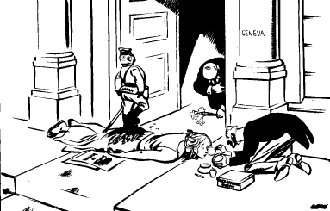The League in Manchuria
| The 1920s had been times of prosperity and democracy. But, after 1930, there was a great depression. Countries now wanted to increase their wealth at other nations' expense. Fascist governments which believed in the survival of the strongest came to power in Germany and Italy. In the 1920s, the League had been quite successful. In the 1930s, it failed terribly. This page looks at its failure in Manchuria, and the next spread looks at its failure in Abyssinia.
|
Going DeeperThe following links will help you widen your knowledge: Japanese foreign policy - summary
Powerpoint - Manchuria
|
Failure in Manchuria, 1932-33The Dispute In the 1930s there was a world-wide economic depression. Japan tried to overcome the depression by building up an empire. In 1932, the Japanese army invaded Manchuria and threw out the Chinese. They set up their own government there and called it Manchoukuo. China asked the League to help.
What the League did: The League sent a group of officials led by Lord Lytton to study the problem (this took a year). In February 1933 it ordered Japan to leave Manchuria.
The Outcome: Japan refused to leave Manchuria. Instead, Japan left the League. Many countries had important trading links with Japan. The League could not agree on sanctions or even a ban on weapons sales. Britain and France did not want a war, so nothing was done. The Japanese stayed in Manchuria. The League had failed.
|
Consider:Why was the League of Nations unable to stop Japan taking over Manchuria in the 1930s? The 'Why the League Failed' webpage suggests seven reasons why the League failed: 1. Weak powers 2. America was not a member 3. The League's structure/organisation was inefficient 4. World Depression made nations less cooperative 5. The more the League failed, the less authority it had 6. Its own members betrayed it and let it down 7. The League faced aggressive military fascist powers How many of these factors can you see at work in the League's failure in the Manchurian crisis - where? Taking these ideas into account, WHY did the League fail in Manchuria?
|
Manchuria: ResultsSource AThe invasion of Manchuria had two important side effects - putting aside for a moment its dreadful revelation that the League was powerless in the face a determined aggressor. First, it raised the prestige of the Japanese Army. Second, it made it possible for the Army to pressurise the Japanese government to undertake a policy of armed expansion. Tony
Howarth, Twentieth Century History (1979).
Source BAmerica's consistent refusal to use nothing more than words in support of the League had shown just how toothless and helpless the international community was when it came to enforcing and upholding the peace. A dangerous precedent had been set. John Costello, The Pacific War (1981)
|
Source CI know this sounds all wrong, perhaps immoral, when Japan is flouting the League of Nations, but: (1) she was greatly provoked, (2) she must ere long expand somewhere - for goodness sake let (or rather encourage) her to do so there instead of Australia and (3) her control of Manchuria means a real block against Communist aggression. A letter from the Master of Peterhouse, Cambridge University,
Consider:Using sources A-E, find and list all the results you can see of the League's failure in Manchuria?
|
Source DThis cartoon of 1933,
by the British cartoonist David Low, is entitled: 'The
Doormat'. Click here for the interpretation
|
Source EThis cartoon was produced in 1933. What is the cartoonist suggesting about Japan? Click here for the interpretation
|


